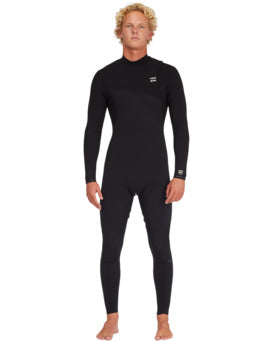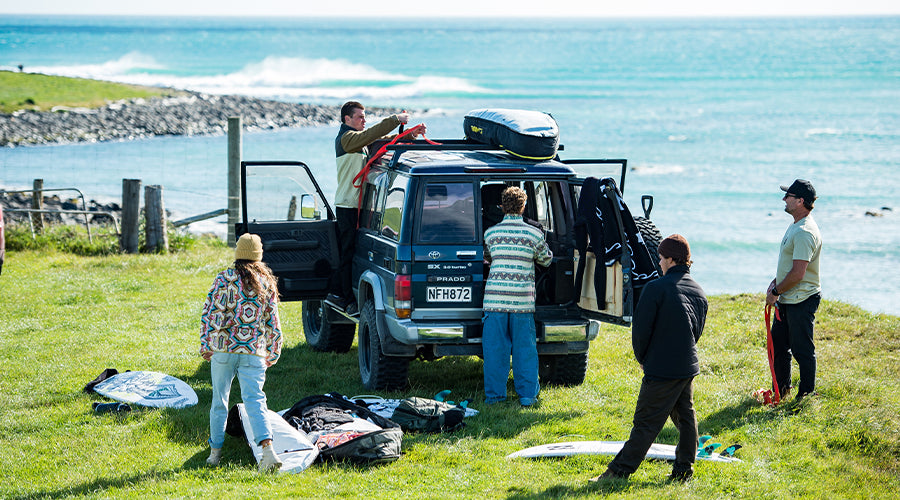One thing is for certain when you travel with a board bag: it's impossible to blend in. They're heavy, large, awkward to carry and you'll inevitably elicit long, puzzled stares and concerned inquiries from passersby. As much of a hassle as it can be, the rewards of riding your favorite board at a perfect, exotic reef is well worth the struggle. Here are a few tips to ensure that the carves far outnumber the curses when you're traveling with surfboard en route:
Considerations for Packing Surfboards for Air Travel
Air travel for surfboards offers one additional key challenge: for the most part, it's out of your control. So, while the tips above are still relevant for sending your board bag abroad, you also need to employ a few extra safeguards to make sure your boards are still intact when you arrive at your destination. Here are three key things to remember before putting your boards in the airlines' hands:
- KEEP IT TIGHT: A loose, floppy boardbag invites movement. When boards move around, they're much more prone to dings and sharp edges. Once you pack your boardbag, pick it up and shake it around. If the boards easily shift, we suggest adding more padding to keep them snug and tight through all turbulence, both in the air and on the conveyor belt.
- WRAP IT UP: Board bags generally scream: "There's a bunch of expensive equipment in here!" For extra security and water resistance, we suggest (recycled) plastic wrap around both ends where the zippers can be accessed.
- MAKE IT PERSONAL: A heavy bag is a heavy bag, which is why a handler might not be as careful if they don't know the person who owns it. It's often a good idea to put a human face on your board bag: write a nice, short note, add a smiley face on that fragile sticker. Just let them know how much your boards mean to you. It can make a difference.

How To Prep Your Surfboard & Pack Your Bag
- Find an open space like a garage floor and start laying everything out. First, select the boards you're going to bring with you and strip them clean. Remove fins, wax, leashes and encase each individual board in a cloth board sock. Store all your accessories – fins, wax, wax comb/scraper, leash, leash strings, ding repair – in one small bag. Set aside.
- You’ll want to add some reinforcement to the nose, tail and edges of your surfboard to keep it safe from dings and dents. You can always wrap them with the shirts and towels in your bag, but a simpler way to keep them safe is by using foam pool noodles. Two of them per board should do the trick – simply cut along the length of them until you hit the hollow center, then insert them onto the edges of your board. Use masking tape or shrink wrap to secure whatever reinforcement you’ve added and avoid using duct tape as it can leave sticky residue once removed.
- Lay out your board bag. Make sure the length of your boards are at least an inch or two shorter than the "length limit" of the board bag. If you're bringing more than one board, select a bag that has removable internal "dividers" between each board. These help protect the boards from each other. If you're carrying a bag with three or more boards, select a board bag with wheels if possible. It'll make a huge difference during airport transit.
- After laying out the board bag flat, start adding your prepped surfboards, one at a time, longest board first. The rocker (curve) of the boards should be facing "out." Add a divider between each board. Once they're all layered in, zip up the board bag, pick it up and give it a "shake test."
- Based on how snug/secure your boards are, you can now open the bag again and start layering in "padding" in the open and vulnerable spaces. Start with towels and wetsuits (if you're taking them) and layer them into the nose and tail areas. Continue with repeated "shake tests" until boards are tight and padded with little to no movement in the bag.
- Zip back open, add in your accessory kit and straps, and either add the "security wrap" around the zippers or head to the airport.
Can You Bring a Longboard on a Plane?
If it meets the maximum height and weight requirements, longboards on airlines are subject to the same process as shortboards: pay the "oversize baggage" fee and you're good to check in. That said, keep in mind that most airlines have "length maximums'' for boardbags ranging anywhere from 9 to 11 feet (check your specific airlines for details). You'll also run into a lot more restrictions with smaller planes, where they simply can't fit boards of this length in the cargo hold.

Board Bag Essentials
Boards: If you’re bringing more than one board, we recommend placing each board into individual day bags before packing them into the larger board bag. You get more padding, and the single bags are perfect for day missions during your trip. If you don’t have day bags, make sure all wax is removed and you place your boards in the bag from longest to smallest, longest board first.

Wetsuit: Definitely try to pack all your wetsuits into your board bag if you’re bringing them. The suits double as padding and board dividers as well, so place them strategically.

Towels: Towels also come in handy as padding (nose and tail of board) and between each board. If you’re surfing a lot, you’ll appreciate multiple towels.
Surfboard Accessories: Accessories (fins, leashes, wax, etc.) should also be placed in your board bag and should be in a self-contained kit. Just make sure there are no sharp edges making direct contact with your boards.
Roof Straps: Roof straps make all the difference on a trip if you plan on traveling to surf spots by rental car or taxi. Slide a pair in your boardbag and watch the transportation options multiply.

Additional Tips for International Surf Travel
Traveling successfully with surfboards is an ongoing mix of art and science. Here are a few other miscellaneous tips to help mitigate the baggage bill at the check-in counter:
-
Be Friendly and Be Prepared
Remember: Airline passenger assistants want the process to run as smoothly as possible. If you come stumbling up to the check-in counter with a giant board bag, you need to do everything to offset the perceived hassle. Have your documents ready. Smile. Ask them about their day. The more personable you can make the interaction, the better the chances that they'll take care of you. -
The Trojan Horse Method
Sometimes, especially when an airport is packed and crazy, it's better to "ease" a passenger assistant into the fact that you have one or more big board bags to check in. Set your board bags off to the side and "out of the way" but still close enough to not draw suspicion. When you go up to check in, casually mention you also have a "board bag" to check in and point to it, letting them know you were trying to keep it out of foot traffic. This approach often softens the blow and may result in a more frictionless check-in process. -
Share The Burden
Make it clear to the passenger assistant and baggage handlers that you're there to help. Offer to carry the board bag to the oversize area and go out of your way to make it as easy for them as possible. No one's going to look kindly on a spoiled surfer who drops their 8-foot board bag in front of the counter and says, "Figure it out." -
Do Your Research
No matter what precautionary measures you take, you're going to find that some airlines are just terrible at handling surfboards. What the best/worst airlines for surfboard travel changes from year to year, so we highly recommend doing the research ahead of time to see how your airline of choice fares by independent surf media sources like Surfline and Stab. These reviews are published annually.

Renting Surfboards Locally
Pros: Pretty much all of the above doesn't apply.
Cons: You'll still be wishing you were riding the board you know and love the entire trip. Plus, dealing with availability and unreliable opening hours.
Air travel with surfboards hasn't changed much in the past few decades. If you want to ride your own board, you're going to deal with the inevitable hassles at the airport. But think of it this way, there are few people on the planet willing to go the extra mile to maximize the fun on their dream vacation. It must be for a good reason, right?